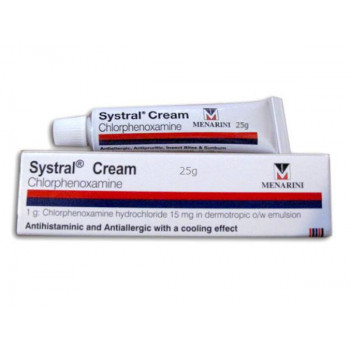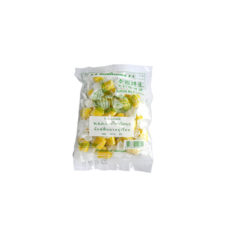Антигистаминный и антиаллергический крем
Антигистаминный и антиаллергический крем
Содержит активный ингредиент: хлорфеноксамин HCL 15 мг
Остановите зуд, получите охлаждающий эффект и уменьшите боль.
Крем SYSTRAL указывается для местного применения при укусах насекомых, умеренных ожогах, солнечных ожогах, ознобе, простудном и аллергическом дерматитах, например, вызванных медузами, экземой.
Не используйте SYSTRAL:
— Если у вас есть специфические кожные процессы (такие как сифилис, туберкулез), ветряная оспа, реакции после вакцинации, микоз, бактериальные кожные инфекции, стероидные угри.
— Беременность и кормление грудью
SYSTRAL должен использоваться во время беременности и лактации, только если он выписан врачом.
Не используйте SYSTRAL больше, чем необходимо
Использование SYSTRAL в расширенных областях кожи, пораженных воспалительными изменениями (ожоги, солнечные ожоги), может вызывать побочные эффекты от большого количества хлорфеноксамина гидрохлорида, особенно у маленьких детей.
В очень редких случаях может возникать беспокойство, путаница и расширение зрачка. У взрослых неблагоприятные эффекты — это в основном усталость и сухость во рту.
Крем против аллергии Systral 10 г / Systral cream 10g
-20%

Отзывы:
(0)
- Код Товара: 8354
- Вес: 0.03кг
- Наличие: В наличии
272.00р.
340.00р.
Нашли дешевле?
Кол-во:
- Обзор товара
- Отзывов (0)
Крем от кожного зуда, аллергии, сыпи, крапивницы, укусов насекомых. Кожа не обгорает на солнце.
Без стероидов
Безопасно для детей и пожилых людей, также для домашних животных
Отзывов (0)
Нет отзывов об этом товаре.

฿110.00
вес 45 г
Для местного лечения аллергических и зудящих кожных заболеваний, таких, как укусы насекомых, медуз ожоги, крапивница и экзема, солнечные ожоги, незначительные ожоги и обморожения.
-
Описание
-
Отзывы (0)
Похожие товары
-

OTOP
Набор тайских пряностей для супа Том Ям / Spices for Cooking Set Tom Yam soup.
40 гр
«Набор тайских пряностей для супа Том Ям
Tom Yam SetНабор засушенных тайских пряностей для приготовления знаменитого тайского супа Том Ям, а также для приготовления кокосового куриного тайского супа Том Ка Кай и различных видов тайского карри – красный карри, зеленый карри или Пананг Карри.
Пакет сушеных пряностей Tom Yam Set, произведено в Таиланде. Вес нетто 40 грамм.»
-

-

Systral® Creme
€35.28
Вся информация представлена исключительно в ознакомительных целях и предназначена только для просмотра, если вас интересует возможность организации доставки лекарств из Германии, свяжитесь с нами одним из следующих способов: телефон,whatsapp,telegram+7(960)4893355 (ru), e-mail: info@farm-de.com
Артикул: 1000203.
Категории: Аллергия & Астма, Каталог 1.
Описание
Форма выпуска: Крем
В упаковке: 20 g
Производитель: MEDA Pharma GmbH & Co.KG
Особые условия транспортировки: НЕТ
Артикул: 1000203
Документация в формате PDF:

Margreet Rost van Tonningen, in Drugs During Pregnancy and Lactation (Second Edition), 2007
2.2.1 Antihistamines (H1-blocker)
Pharmacology
Antihistamines are substances that competitively block the action of histamine on the histamine receptors. Histamine release results in the stimulation of H1-receptors located on the smooth muscles of many organs, or H2-receptors located in the mucosa of the stomach, producing an increase in acid secretion. Only the blocking of the H1-receptors is essential in antiallergy therapy.
H1-antihistamines are mostly used in antiallergy therapy; some are used as antiemetics and some as sedatives. The less sedating antihistamines are preferred for antiallergy therapy.
Of the first-generation antihistamines, alimemazine, bamipine, brompheniramine, carbinoxamine, chlorpheniramine, chlorphenoxamine, clemastine, cyproheptadine, dexchlorpheniramine, dimetindene, diphenhydramine, hydroxyzine, mebhydroline, oxatomide, pheniramine, triprolidine, and tripelenamine among others, have been or are still used as antiallergic drugs.
Second- and third-generation antihistamines such as acrivastin, astemizole, azelastine, cetirizine, desloratadine, ebastin, fexofenadin, levocabastine, levocetirizine, loratadine, mequitazine, mizolastine, oxatomide, terfenadine, and tritoqualin are less sedating than the first-generation agents. The half-lives for astemizole and for terfenadine are very long (20–26 hours, astemizole metabolites 9 days!). Serious cardiovascular events and potentially serious drug interactions have been reported with respect to terfenadine and astemizol. In many countries, astemizole and terfenadine have been removed from the market. Some of the above-mentioned drugs are only available for local use. For azelastine and oxatomide, see also Chapter 2.3.
Toxicology
First-generation antihistamines
A large number of pregnancies exposed to first-generation anti-histamines such as chlorpheniramine, clemastine, dexchlorpheniramine, dimetindene, diphenhydramine, hydroxyzine, mebhydroline, and pheniramine have been studied to date. No increased teratogenic risk has been detected (Gilbert 2005, Källén 2002, 2003, Schatz 1997, Lione 1996).
Only a limited number of pregnancies exposed to brompheniramine, cyproheptadine, triprolidine, and tripelenamine have been studied, but no increased risk of congenital malformations was noted (Mazzotta 1999). In animal experiments, cyproheptadine was toxic to fetal pancreatic cells. The comparable effects in humans have not been reported, but experience with the use of cyproheptadine in pregnancy is very limited.
One study uncovered an association between the use of antihistamines during the 2 weeks preceding delivery and an increased risk of retrolental fibroplasia (Zierler 1986). Other investigators have not confirmed this association.
Diphenhydramine and dimenhydrinate, when used parenterally in late pregnancy, may stimulate uterine contractions, leading to concern about fetal hypoxia (Broussard 1998; see also Chapter 2.4).
Withdrawal symptoms (e.g. generalized tremulousness and diarrhea) have been reported after the use of the antihistamines diphenhydramine and hydroxyzine throughout pregnancy (Lione 1996). A recent publication reports on a term newborn with tonic–clonic seizures starting 4 hours after birth, whose mother had received 150mg hydroxyzine per day for anxiolysis. The newborn’s plasma levels paralleled those of its mother 6 hours after birth. The authors interpreted the seizures as withdrawal symptoms. The neurological development was uneventful at the age of 6 months (Serreau 2005).
Second- and third-generation antihistamines
Among 66 pregnant women exposed to acrivastin during early pregnancy, no indication for teratogenicity was observed (Källén 2002, Wilton 1998).
In prospective studies on astemizole use in 187 pregnancies, no association was found between astemizole exposure in the first trimester and the occurrence of congenital malformations or other adverse effects (Diav-Citrin 2003, Pastuszak 1998). However, like terfenadine, astemizole has been withdrawn in many countries because of cardiotoxicity.
There is a fair amount of experience with the use of cetirizine – an active metabolite of hydroxyzine – during pregnancy. In a very small prospective study (39 pregnancies), cetirizine use during the first trimester was not associated with a teratogenic risk (Einarson 1997). Two recent prospective controlled studies by members of the European Network of Teratology Information Services (ENTIS) demonstrated no increased risk of congenital malformations or other adverse effects after exposure to cetirizine during pregnancy, of which 292 were first-trimester exposures (Weber-Schöndorfer 2005, Paulus 2004). Data from the Swedish Medical Birth Registry on cetirizine exposure during pregnancy (n = 917) confirm these findings (Källén 2002).
Among 39 first-trimester exposures, there were no indications for teratogenicity of ebastin (Källén 2002).
Post-marketing prescription-event monitoring found no drug-related adverse outcome in 47 pregnancies exposed to fexofenadine, the active metabolite of terfenadine (Craig-McFeely 2001).
The best-studied second-generation antihistamine is loratadine. Data on more than 4000 exposed pregnancies are documented. The Swedish Medical Birth Registry reported finding a prevalence of hypospadias in male offspring that was twice that of the general population among approximately 3000 women who had taken loratadine in pregnancy (Källén 2001). This report had a number of design limitations. The finding of an increased risk of hypospadias was not confirmed in various subsequent studies and reports. Two prospective controlled studies found no increased risk of congenital malformations and no cases of hypospadias after exposure to loratadine in approximately 370 pregnancies, of which 336 were exposed at least during the first trimester (Diav-Citrin 2003, Moretti 2003). Unpublished data of the European Network of Teratology Information Services (ENTIS) on loratadine exposure during pregnancy did not yield any case of hypospadias to date. Investigators at the Centers for Disease Control analyzed data from the National Birth Defects Prevention Study. The use of loratadine was identified in only 1.7% of the entire study population, and no statistical association with the use of loratadine (or other antihistamines) and hypospadias was detected in these data (Werler 2004). An examination of Danish birth registries, reported in abstract, identified cases of hypospadias and investigated prescription records for each case and a matched control group. This study did not find a significant association between maternal exposure to loratadine and an increased risk of hypospadias (Pedersen 2004). To date, continuous post-marketing surveillance has found no further evidence of an increased risk of hypospadias.
In prospective studies covering almost 300 pregnancies, and one record linkage study on terfenadine use during pregnancy, no increased risk of malformations could be detected after the first-trimester use (Diav-Citrin 2003, Loebstein 1999, Schick 1994). Data from the Swedish Medical Birth Registry on terfenadine exposure during pregnancy confirm these findings (Källén 2002). However, terfenadine has been withdrawn in many countries because of cardiotoxicity.
There are absent or few human data on the use of the following antihistamines: bamipine, carbinoxamine, desloratadine, levocabastine, levocetirizine, mequitazin, mizolastine, and tritoqualin (Gilbert 2005, Källén 2002).
Recommendation.
First-generation H1-blockers like chlorpheniramine, dexchlorpheniramine, mebhydroline, clemastine, and dimetindene can be used during pregnancy for the treatment of allergic conditions. As the best-studied second-generation antihistamine, loratadine can be used during pregnancy for the treatment of allergic conditions. Cetirizine could be an acceptable second choice. It should be noted that neonatal respiratory depression has been reported after perinatal use of some first-generation antihistamines. To date, the inadvertent use of the new and/or less well-documented antihistamines does not require termination of pregnancy or invasive diagnostic procedures. When feasible, local treatment with intranasal sodium cromoglycate, beclomethason or budesonide is preferred in conditions like allergic rhinitis etc. (see Chapter 2.3).
